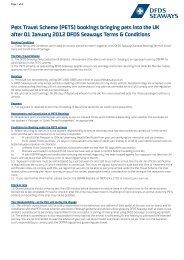TEL: 08715 747218 - DFDS Seaways
TEL: 08715 747218 - DFDS Seaways
TEL: 08715 747218 - DFDS Seaways
You also want an ePaper? Increase the reach of your titles
YUMPU automatically turns print PDFs into web optimized ePapers that Google loves.
When thinking of the war-torn<br />
regions of Belgium and Northern<br />
France it’s easy to forget a<br />
conflict a century earlier that<br />
brought many of the<br />
protaganists in the two World<br />
Wars together in a different<br />
political alignment, namely the<br />
Battle of Waterloo in 1815.<br />
Nelson had defeated the French<br />
at sea in the Battle<br />
of Trafalgar in 1805 and<br />
Napoleon had been forced<br />
to abdicate in 1814. He was<br />
banished by the Allies to the<br />
Island of Elba. The French,<br />
disaffected with Louis XVIII,<br />
rallied behind Napoleon, who<br />
escaped in February 1815, and<br />
re-grouped as he wanted to split<br />
the coalition of nations against<br />
him that included Prussia,<br />
Holland and Britain together<br />
with Nassau, Hanover and<br />
Brunswick.<br />
Waterloo Tourist Office<br />
Chausée de Bruxelles 218<br />
Tel: 00 32 (0)2 352 0910<br />
Fax: 00 32 (0)2 354 2223<br />
The Battle of Waterloo<br />
1815<br />
Waterloo was the culmination of<br />
three previous battles and on 18<br />
June 1815 the combined forces<br />
of Prussia and the United<br />
Kingdom finally over-threw<br />
Napoleon Bonaparte. It was a<br />
triumph for the Duke of<br />
Wellington, who described it as,<br />
‘the nearest run thing you ever<br />
saw in your life’, and a landmark<br />
in British history. The British<br />
forces suffered some 5,000<br />
casualties (killed and wounded),<br />
the Prussians 7,000 and the<br />
French 25,000 and 7,000<br />
prisoners of war. The Wellington<br />
Museum, south west of Waterloo,<br />
will make a visit to the actual<br />
battlefield and the Lion’s Mount<br />
so much more evocative. The<br />
visitors’ centre there screens a<br />
short film and Napoleon’s last<br />
headquarters and the Panorama<br />
of the Battle widen your understanding<br />
of this battle further.<br />
Images: © OPT<br />
Combination Ticket<br />
A combination ticket is great<br />
value and admits visitors to:<br />
Lion’s Mount & Panorama<br />
Visitor’s Centre, Braine-L’Alleud<br />
Route du Lion 254,<br />
Braine-l’Alleud<br />
Tel: 00 32 (0)2 385 1912<br />
www.waterloo1815.be<br />
Apr - Oct 09.30-18.30<br />
Nov - Mar 10.00-17.00<br />
The Last Headquarters of<br />
Napoleon, Vieux-Genappe<br />
Chausée de Bruxelles 66,<br />
Vieux-Genappe<br />
Tel: 00 32 (0)2 384 2424<br />
The Wellington Museum,<br />
Waterloo<br />
Chaussée de Bruxelles 147<br />
B1410 Waterloo<br />
Tel: 00 32 (0)2 357 28 60<br />
www.museewellington.com<br />
Open every day except<br />
1 Jan & 25 Dec<br />
1 Apr - 30 Sep 09.30-18.30<br />
1 Oct - 31 Mar 10.00-17.00<br />
COMBINATION TICKET:<br />
Adult: €12<br />
Child: €7.50<br />
Image: © O. T. Mons<br />
Mons Tourist Office<br />
Grand’Place 22<br />
7000 Mons<br />
Tel: 00 32 (0)65 335 580<br />
Fax: 00 32 (0)65 356 336<br />
Image: Michel Lefrancq<br />
The Battle of Mons<br />
WW1<br />
By the 23 August, only 20<br />
days after Germany declared<br />
war on France, British troops<br />
were in position at Mons to<br />
support the French. However,<br />
the allied forces were<br />
outnumbered 20:1 along a<br />
45km front and were forced<br />
to evacuate the town of<br />
Mons and withdraw. Legend<br />
has it that some soldiers saw a vision of an angel in the sky giving<br />
courage to the retreating British Army. A painting in Mons Town<br />
Hall depicts ‘The Angel of Mons’, now believed to be the creation<br />
of a journalist.<br />
Mons<br />
WW2<br />
The town came under attack on 10 May 1940 and was occupied<br />
9 days later. The next attack on Mons came from the Allies and it<br />
was liberated on 2 September 1944 by American forces, who<br />
subsequently took 27,000 prisoners.<br />
There is a Museum of Military History in Mons covering both<br />
conflicts and, outside the town, 230 British servicemen’s graves<br />
from WW1 are to be found at the St Symphorien Military Cemetery,<br />
set in quiet countryside.<br />
<strong>TEL</strong>: <strong>08715</strong> <strong>747218</strong> 27







